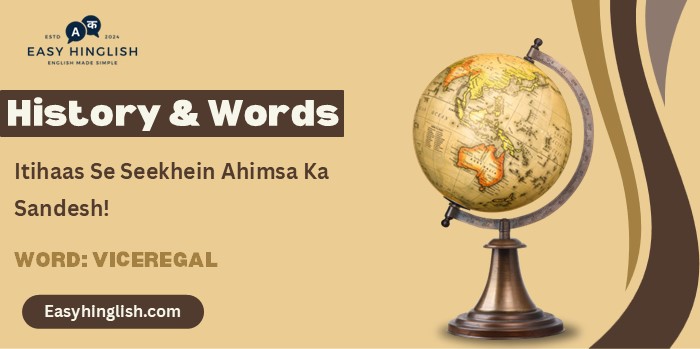History & Words: ‘Viceregal’ (15 August)
Welcome to ‘History & Words’! 🌟 Main hoon Prashant, Wordpandit aur Learning Inc. Network ka founder. Yeh series language learning aur historical context ko connect karti hai, taaki vocabulary improve ho aur history ki understanding bhi deep ho.
Chaliye, shabdon ki iss journey par mere saath chaliye aur naye naye words explore karte hain! 😊
🔍 Word of the Day: Viceregal
Pronunciation: /vaɪˈsɪriːɡəl/ (vy-SIR-ee-guhl)
Definition: Relating to a viceroy or the office of a viceroy; describing the powers, authority, or administrative structure of a colonial representative ruling on behalf of a monarch.
🌍 Parichay (Introduction)
15 August 1947—as the clock struck midnight, India awoke to freedom, and a chapter of viceregal governance finally closed.
For nearly 200 years, India had been ruled by the British Empire, governed largely through viceregal authority—a colonial system where a viceroy acted in the name of the British Crown.
That night, a civilization older than its colonizers reclaimed its voice, while simultaneously enduring the heartbreak of Partition.
Aaj ka shabd Viceregal us puraane raaj ka pratinidhitva karta hai—jo unka tha jo yahaan rehte nahi the, lekin phir bhi raaj karte the.
🌱 Shabd ka Utpatti (Etymology)
Viceregal is formed from:
– Vice- = in place of
– Regal = king or monarch
Toh Viceregal ka literal arth hai: “in place of the king”—used to describe a viceroy’s duties and aura, especially in colonies like India under the British Raj.
📖 Mahatvapurn Shabdavali (Key Vocabulary)
- 🔑 Viceregal: Pertaining to a viceroy or the colonial structure he represents
- 🔑 Viceroy: A royal official who governs a territory as the monarch’s representative
- 🔑 British Raj: Period of British rule in India (1858–1947)
- 🔑 Partition: Division of British India into India and Pakistan
- 🔑 Mountbatten Plan: Final framework for Indian independence and Partition
- 🔑 Sovereignty: Supreme power or authority reclaimed by India on this day
🏛️ Itihasik Sandarbh (Historical Context)
After the Indian Rebellion of 1857, power transferred from the East India Company to the British Crown
– The Viceroy of India became the highest colonial authority
– From Lord Canning to Lord Mountbatten, 33 viceroys governed in the name of the British monarch
15 August 1947:
– Lord Mountbatten, the last viceroy, oversaw the handover of power
– Jawaharlal Nehru delivered the iconic “Tryst with Destiny” speech
– Simultaneously, Partition tore through Punjab and Bengal, displacing millions and causing mass bloodshed
Viceregal rule ended—but its consequences lingered in borders, bureaucracy, and broken families.
⏳ Samayrekha (Timeline)
- 1858: British Crown assumes control—first Viceroy appointed
- 1919–1942: Nationalist movements intensify
- 3 June 1947: Mountbatten Plan announced
- 15 August 1947: Independence achieved, viceregal rule ends
- 26 January 1950: India becomes a Republic with its own constitution
🌟 Is Din ka Mahatva (The Day’s Significance)
15 August ka arth hai:
✅ Farewell to viceregal authority, colonial chains, and monarchy
✅ The birth of a sovereign, secular, democratic republic
✅ Simultaneously, the wounds of Partition began to bleed
✅ Ek din jisme celebration aur shok, azadi aur alagav, dono ek saath the
Yeh din batata hai: Har independence ek farewell bhi hota hai—kabhi rajnaitik, kabhi manavik.
💬 Prasiddh Ukti (Quote)
“At the stroke of the midnight hour, when the world sleeps, India will awake to life and freedom.”
— Jawaharlal Nehru, 15 August 1947(Matlab: Viceregal silence ko tod kar ek awaaz ne naye yug ki ghoshna ki.)
🔮 Aaj Ka Matlab aur Chintan (Modern Usage & Reflection)
Aaj Viceregal ka arth zyada symbolic ho gaya hai:
✅ Architectural references (e.g. Viceregal Lodge in Shimla)
✅ Colonial studies: Discussing legacy systems and institutions
✅ Power critique: As metaphor for unaccountable authority
✅ Postcolonial discourse: Examining residual colonial mindsets
Yeh term hume yaad dilata hai: Jab tak vichar viceregal hain, tab tak satta swatantra nahi hoti.
🏛️ Virast (Legacy)
✅ The end of viceregal rule marked India’s transformation into the world’s largest democracy
✅ Independence inspired anti-colonial movements across Africa and Asia
✅ British colonial institutions—law, railways, civil services—remained but were repurposed
✅ It also marked one of the largest forced migrations in human history
🔍 Tulnatmak Vishleshan (Comparative Analysis)
Pehle: Viceregal was a symbol of imperial administration
Baad me: Became associated with authoritarianism cloaked in grandeur
Aaj: Represents a colonial past reclaimed by sovereign voices
Yeh shift batata hai: History ko rewrite karne ke liye kabhi kabhi uske har symbol ko samajhna padta hai.
💡 Kya Aapko Pata Hai? (Did You Know?)
🎓 Antim Vichar (Conclusion)
‘Viceregal’ ek aisa shabd hai jo raaj ki shaan ke peeche chhipe shasan ka pratinidhitva karta hai.
15 August 1947 ko India ne us sadiyon purane prashasanik dhanche ko alvida kaha—aur ek naye rashtra ka janm diya.
Aaj jab hum sovereignty, self-rule, aur memory ki baat karte hain—Viceregal reminds us:
“Freedom isn’t just the end of foreign rule—it’s the beginning of self-definition.”
📚 Aage Padhne Ke Liye (Further Reading)
- 📖 Freedom at Midnight – Dominique Lapierre & Larry Collins
- 📖 India After Gandhi – Ramachandra Guha
- 📖 From the Ruins of Empire – Pankaj Mishra
- 📖 The Discovery of India – Jawaharlal Nehru
- 📖 Inglorious Empire – Shashi Tharoor








